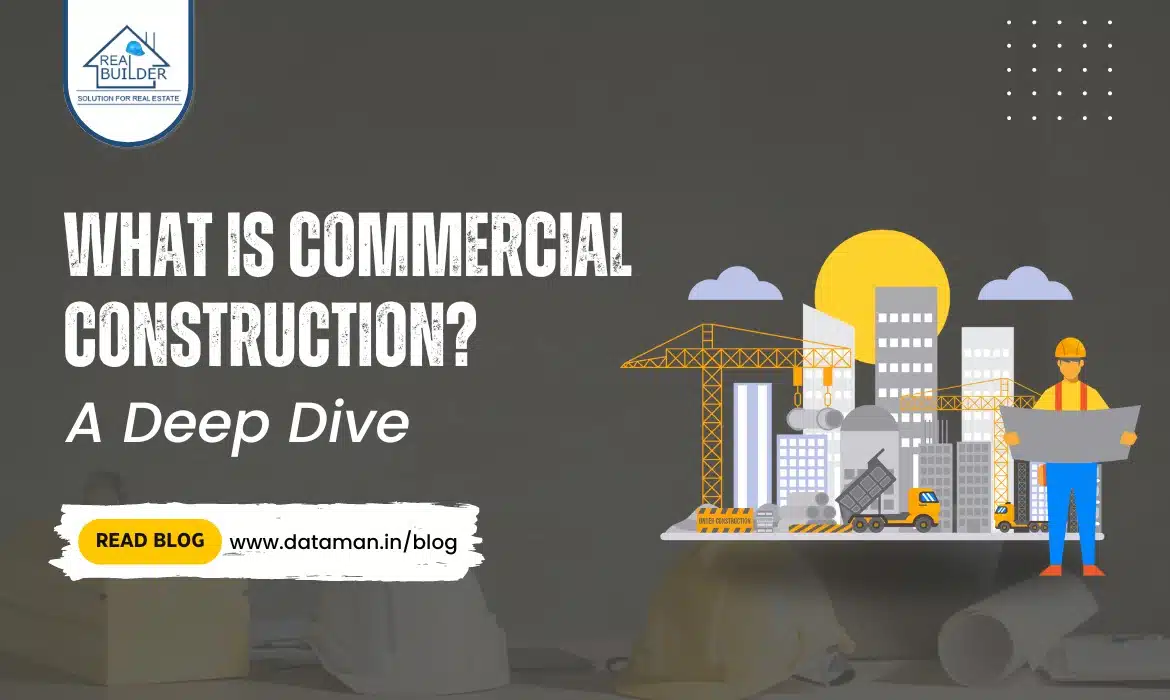- +91 9511117684
- shweta@dataman.in

Table of Contents
Post Views: 9,880
Commercial construction often faces misconceptions, with many people assuming it’s just a larger version of residential building projects. However, a recent literature review highlighted the growing complexity and scale of commercial construction, revealing how these projects require specialized knowledge and advanced planning far beyond what most expect.
To clarify, commercial construction involves the design, renovation, and building of structures intended for business purposes, such as offices, retail spaces, or industrial facilities. This differs significantly from residential construction, which focuses solely on homes and apartments for private living.
In this blog, we will provide a comprehensive overview of commercial construction, exploring the unique aspects of this sector, its types, differences with residential construction and key trends shaping the industry today.
Read More: A Comprehensive Overview of Basic Building Components
Understanding Commercial Construction
Commercial construction refers to the building or renovation of structures that are used for business purposes. These can include office buildings, retail spaces, restaurants, cafes, hotels, educational buildings, sports complexes, etc.
Commercial construction projects often involve more complex planning, design, and engineering than residential construction, as they need to meet specific requirements for functionality, safety, and accessibility.
They also require coordination with various stakeholders, including architects, engineers, contractors, and property owners.
According to a report by Construction Week, the commercial real estate industry in India is expected to grow at a CAGR (Compound Annual Growth Rate) of approximately 13% during the period 2022- 2027.
Types of Commercial Construction
Commercial construction encompasses a wide range of building types, each with its own unique requirements and challenges. Here’s a breakdown of some of the most common types:
1. Office Buildings
Office buildings are perhaps the most common type of commercial construction. They can range from small, single-story structures to towering skyscrapers. Office buildings can further be classified into corporate offices, public sector offices, co-working spaces, and more.
2. Retail Spaces
Retail spaces can vary widely in size and scope, from small neighbourhood shops to large shopping malls. Office buildings can further be classified into shopping malls, strip centres, specialty stores and more.
3. Industrial Facilities
Industrial facilities are designed to support manufacturing, warehousing, and other industrial processes. They can range from small workshops to large-scale factories. Some common types include warehouses, factories, manufacturing plants and more.
4. Hospitality Venues
Hospitality venues provide lodging and other services to travellers. They can range from budget-friendly motels to luxury resorts. Some common types include hotels, resorts, motels, restaurants, B&B (Bed and Breakfast), and more.
5. Educational Institutions
Educational institutions provide educational services to students of all ages. They can range from small private schools to large public universities. Some common types include schools, universities, colleges, coaching centres and more.
6. Sports Complex
Sporting events are conducted within the sports complex. Some of the common types of sports complexes are stadiums, golf course, arena, racing tracks, inside game premises and more types of sports complexes for large and small spectator gatherings.
7. Medical Facilities
Medical facilities include hospitals, pharmacy, pathology lab, radiology lab, medical research centre, blood bank, etc. The facilities adhere to strict safety and health regulations.
Read More: How Construction ERP Software Unifies Your Business Operations
Commercial vs. Residential Construction: Key Differences
While both commercial and residential construction fall under the umbrella of private construction, they differ significantly in scale, financing, site size, and equipment requirements.
| Parameter | Commercial Construction | Residential Construction |
|---|---|---|
| Scale | Typically larger, involving multiple stories, larger buildings, or expansive complexes. | Smaller, typically focusing on single-family homes or small apartment complexes. |
| Financing | Funded by private investments, commercial loans, or a combination. Often attracts investors seeking long-term returns. | Funded by private investments and mortgages, often by individual homeowners or small-scale developers. |
| Site Size | Requires more extensive sites to accommodate large buildings, parking, and multiple structures. | Smaller, focused on individual homes or small complexes. |
| Equipment | Requires specialized equipment like cranes, heavy machinery, and advanced construction technology. | Generally requires less specialized equipment, with basic machinery suitable for small- to medium-scale projects. |
Read More: Understanding the Different Types of Tender in Construction
Levels of Commercial Construction
Commercial construction projects can range from small-scale renovations to massive, multi-year infrastructure projects. Here’s a breakdown of the different levels:
1. Small-Scale Construction
Scope: Typically involves minor renovations, repairs, or expansions.
Timeline: Relatively short, often completed within a few weeks or months.
Equipment: Requires less specialized equipment and a smaller workforce.
Examples:
. Installing new windows, doors, or roofing
. Interior office renovations
. HVAC system upgrades
2. Mid-Scale Construction
Scope: Involves more significant upgrades, expansions, or new construction.
Timeline: Longer than small-scale projects, often lasting several months or a year.
Equipment: Requires more specialized equipment and a larger workforce.
Examples:
. Building mid-size offices, hotels, or medical facilities.
. Constructing a new wing for an existing building
3. Large-Scale Construction
Scope: Involves major changes to the building footprint or the creation of entirely new structures.
Timeline: Extensive, often lasting several years.
Equipment: Requires highly specialized equipment and a large, coordinated team.
Examples:
. Building skyscrapers, shopping malls, or large office complexes
. Infrastructure projects like airports or bridges
Key Difference
| Feature | Small-Scale | Mid-Scale | Large-Scale |
|---|---|---|---|
| Scope | Minor | Significant | Major |
| Timeline | Short | Medium | Long |
| Equipment | Less Specialized | More Specialized | Highly Specialized |
| Workforce | Smaller | Larger | Very Large |
Read More: Top 10 Construction Companies in India
Conclusion
In conclusion, commercial construction encompasses a wide range of building projects, from towering office buildings to sprawling industrial facilities. This complex process involves a collaborative effort among developers, contractors, architects, engineers, and subcontractors, each playing a crucial role in delivering successful projects.
FAQs: Commercial Construction
What is commercial construction project management?
Commercial construction project management involves overseeing the planning, execution, and completion of commercial building projects, which can be done efficiently through a robust ERP Software for construction.
What is an example of a commercial construction project?
A perfect example of a commercial construction project is corporate offices. Other examples of commercial construction include shopping malls, hotels, restaurants, institutional buildings, etc.
What is the meaning of commercial building?
A commercial building is a structure designed and built for business purposes.
0

